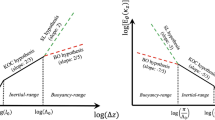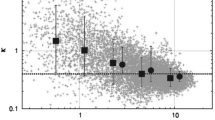Abstract
During the late nineteenth century, remarkable advancements were achieved in the field of atmospheric measurement systems, particularly through the implementation of direct aerological sounding techniques. Subsequently, starting from 1900, these measurements have been conducted consistently under the auspices of the International Aerological Commission. Concurrently, significant progress was also made in theoretical hydrodynamics, marking a new era in the evolution of theoretical meteorology. One of the notable pioneers in this domain was Wilhelm Freeman Bjerknes (1862–1951), who revolutionized the field with his renowned circulation theorem. In April 1897, Wilhelm Freeman Bjerknes discussed the circulation theorem with his students during theoretical physics classes at the University of Stockholm. He later published a preliminary version of the theorem in 1898, followed by its complete form in 1902. Notably, in 1896, Silberstein had already published one of the two circulation theorems in Krakow. However, Silberstein regarded the baroclinic state merely as a transitional phase, without delving into its practical implementation. In contrast, Bjerknes emphasized the application of the circulation theorem, establishing himself as the true inventor of this theorem due to his comprehensive exploration of its practical implications.
In April 1897, Wilhelm Freeman Bjerknes imparted his knowledge of the circulation theorem to his students during theoretical physics classes at the University of Stockholm. He initially published a preliminary version of the theorem in 1898, followed by its comprehensive form in 1902. It is worth noting that in 1896, Silberstein had already published one of the two circulation theorems in Krakow. However, Silberstein’s focus was primarily on the baroclinic state as a transitional phase, without discussing its practical implementation. In contrast, Bjerknes not only introduced the circulation theorem but also emphasized its real-world application. As a result, he can be regarded as the true originator of this theorem.
Access this chapter
Tax calculation will be finalised at checkout
Purchases are for personal use only
Similar content being viewed by others
References
Bergeron, T. 1959. Methods in scientific weather analysis and forecasting: An outline in history of ideas and hints at a program. In The atmosphere and the sea in motion, ed. B. Bolin, 440–474. Rockefeller Institute Press.
Bundgaard, R.C. 1979. Sverre Petterssen, weather forecaster. The Bulletin of the American Meteorological Society 60: 182–195.
Friedman, R.M. 1987. Constituting the polar front, 1918–1919. Isis 73: 343–362.
Galileo, G., trans. H. Crew and A. DeSalvio. 1939. Dialogues concerning two new sciences, 64–68. Chicago: Northwestern University Press.
Jewell, R. 1981. The Bergen School of Meteorology: The cradle of modern weather-forecasting. The Bulletin of the American Meteorological Society 62: 824–830.
———. 1984. The meteorological judgment of Vilhelm Bjerknes. Social Research 51: 783–807.
Namias, J. 1980–1981. The early influence of the Bergen school on synoptic meteorology in the United States. Pure and Applied Geophysics 119: 491–500.
———. 1983. The history of the polar front and airmass concepts in the United States: An eyewitness account. The Bulletin of the American Meteorological Society 64: 734–755.
———. 1991. Francis W. Reichelderfer, August 6, 1895-January 26, 1983. National Academy of Sciences Biographical Memoirs 60: 272–291.
PAGEOPH. 1980. Bergeron memorial volume. Basel: Birkhauser Verlog.
Author information
Authors and Affiliations
Corresponding author
Rights and permissions
Copyright information
© 2023 The Author(s), under exclusive license to Springer Nature Switzerland AG
About this chapter
Cite this chapter
Ćurić, M., Spiridonov, V. (2023). Bergen Synoptic School. In: History of Meteorology. Springer, Cham. https://doi.org/10.1007/978-3-031-45032-7_13
Download citation
DOI: https://doi.org/10.1007/978-3-031-45032-7_13
Published:
Publisher Name: Springer, Cham
Print ISBN: 978-3-031-45031-0
Online ISBN: 978-3-031-45032-7
eBook Packages: Earth and Environmental ScienceEarth and Environmental Science (R0)




